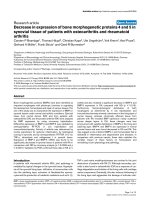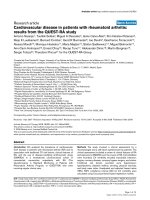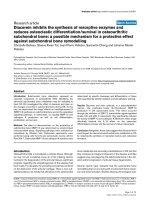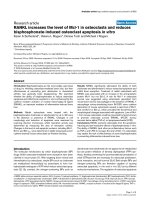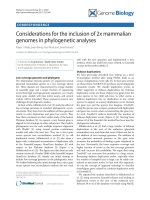Báo cáo y học: "Decrease in the incidence of total hip arthroplasties in patients with rheumatoid arthritis - results from a well defined population in south Sweden" doc
Bạn đang xem bản rút gọn của tài liệu. Xem và tải ngay bản đầy đủ của tài liệu tại đây (232.55 KB, 6 trang )
RESEARCH ARTICLE Open Access
Decrease in the incidence of total hip
arthroplasties in patients with rheumatoid
arthritis - results from a well defined population
in south Sweden
Korosh Hekmat
1*
, Lennart Jacobsson
1
, Jan-Åke Nilsson
1
, Ingemar F Petersson
2
, Otto Robertsson
2
, Göran Garellick
3
and Carl Turesson
1
Abstract
Introduction: One aim of modern pharmacologic treatment in rheumatoid arthritis (RA) is to prevent joint
destruction and reduce the need for surgery. Our purpose was to investigate secular trends in the incidence of
primary total hip and knee arthroplasties in a well defined sample of patients with RA.
Methods: Prevalent cases with RA in 1997 and incident cases from 1997 to 2007 in a community based register in
Malmö, south Sweden, were included. Based on a structured review of the medical records, patients were classified
according to the 1987 ACR criteria for RA. This cohort was linked to the Swedish Hip Arthroplasty Register (through
December 2006) and the Swedish Knee Arthroplasty Register (through October 2007). Patients with a registered
total hip or knee arthroplasty before 1997 or before RA diagnosis were excluded. Incidence rates for the period of
introduction of TNF inhibitors (1998 to 2001) were compared to the period when biologics were part of the
established treatment for severe RA (2002 to 2006/2007).
Results: In the cohort (n = 2,164; 71% women) a primary hip arthroplasty was registered for 115 patients and a
primary knee arthroplasty for 82 patients. The incidence of primary total hip arthroplasties decreased from the
period 1998 to 2001 (12.6/1,000 person-years (pyr)) to 2002 to 2006 (6.6/1,000 pyr) (rate ratio (RR) 0.52; 95%
confidence interval (CI) 0.35 to 0.76). There was a trend towards an increase of primary kne e arthroplasties
(incidence 4.8/1,000 pyr vs. 6.8/1,000 pyr; RR 1.43; 95% CI 0.89 to 2.31).
Conclusions: Our investigation shows a significant decrease in the incidence of total hip arthroplasties in patients
with RA after 2001. Possible explanations include a positive effect on joint damage from more aggressive
pharmacological treatment.
Introduction
Rheumatoid arthritis ( RA) is a systemic inflammatory
disease in which persistent active inflammation leads to
major joint destruction. Chronic destructive arthritis
causes suffering and impaired function for the patient as
well as substantial costs for the health care system and
society due to increased need for hospital admissions
and orthopedic surgery. RA has also been associated
with increased mortality compared with the general
population [1], and increased incidence of cardiovascular
disease in patients with RA has been confirmed in stu-
dies in recent years [2,3].
The aim of pharmacological treatment in RA is to
reduce inflammation, improve function and prevent
long-term joint damage. Disease-modifying anti-rheu-
matic drugs (DMARDs), including inhibitors of tumor
necrosis factor (TNF) and other biologic immunomodu-
lating agents, are used to reduce inflammation and dis-
ease progression. These medications are efficient in
many patients, but are also costly.
* Correspondence:
1
Section of Rheumatology, Department of Clinical Sciences, Malmö, Lund
University and Skåne University Hospital, Södra Förstadsgatan 101, 205 02
Malmö, Sweden
Full list of author information is available at the end of the article
Hekmat et al . Arthritis Research & Therapy 2011, 13:R67
/>© 2011 Hekmat et al.; licensee BioMed Central Ltd. This is an open access articl e distributed under the terms of the Creative Commons
Attribution License ( which perm its unrestricted use, distribution, and reproduction in
any medium, provided the original work is properly cited.
Health economic evaluations of the treatment for RA
need to take into account the impact of indirect costs
(for example, from sick leave or early retirement) and
direct medical costs (health careresourceutilization,
including admissions and surgery). Orthopedic surgery
has been increasingly available in recent years and total
joi nt arthroplasty is used earlier and more frequent ly in
osteoarthritis. A recent study suggests that this has not
beenthecaseinpatientswithRA,possiblyduetosuc-
cessful early treatment of inflammation [4]. Two other
studies have shown an overall reduced rate over time of
joint surgery in patients with RA [5,6].
In a study of a population based RA sample from
Rochester, Minnesota, the cumulative incidence of ortho-
pedic surgery by decade of RA diagnosis was investigated.
In this sample, patients diagnosed with RA after 1985
were less likely to requi re joint surgery overall [5]. A
study performed at the Department of Orthopaedic Sur-
gery, Karolinska University Hospital, Stockholm, Sweden,
showed a decrease in the rates of hospital admission
caused by lower limb surgery in patients with rheumatoid
arthritis between 1987 and 2001. This may reflect trends
in disease severity, management, and health outcomes of
this disease in Sweden [6]. Issues such as the imp act of
differences in access to health care and changes in the
management of RA on the need for orthopedic surgery in
patients should be further studied.
The Swedish national registers for hip and knee
arthroplasties are excellent resources for the study of
changes in the inci dence of such procedures over time.
Previous analyses based on the Swedish Hip Arthro-
plasty Register demonstrated a decline in the proportion
of total h ip arthroplasties (THA) due to inflammato ry
jointdiseasefrom5%ofallTHAduringtheperiod
1992 to 20 02 to 2% in 2007 [7]. A recent survey from
the Swedish Knee Arthroplasty Register showed that the
incidence of total knee arthroplasties (TKA) in Sweden
with a diagnosis of RA noted in the register declined
during the period 1997 to 2007 from 6/100,000 to 2/
100,000 [8]. Although these studies provide reliable
information on THA and TKA, the RA diagnoses used
have not been validated, and the denominator popula-
tion of patients with RA is not defined.
The aim of the present study was to investigate trends in
the incidence of primary THA and TKA in a well defined
sample of patients with RA. In order to do this we studied
the inci dence of first hip and knee joi nt arthroplasty in a
community setting, using a register containing the major-
ity of patients with RA in this geographical area.
Materials and methods
Patients with RA
In 1997, a register of all known patients with RA in the
city of Malmö, Sweden, was established. Inclusion was
based on a clinical diagnosis of RA b y a rheumatologist
and fulfilment of the 1987 A merican College of Rheu-
matology (ACR) criteria for RA [9].
Patients were recruited from the rheumatology outpa-
tient clinic of Malmö University Hospital, which is the
only hospital serving the city, and from the four rheu-
matologists in private practice in Malmö [10]. The pre-
valence of RA and the sex and age distributions in the
Malmö RA register were found to be comparable to the
RA prevalence in studies from Halland in Sweden, and
to the data from a population-based RA register in
Oslo, Norway [11,12]. Subsequent surveys using the
diagnostic index of primary care centers and question-
naires sent to other physicians in the area indicate that
>90% of all patients with diagnosed RA in the city at
that time were included in the register. All patie nts are
registered using the unique national 10-digit ID number
assigned to all Swedish residents who were alive in 1947
or born thereafter. Additional patients with a registered
diagnosis of RA were identified using the Swedish
National Patient Register [13] and the local patient
administrative system, and after 2002 a continuously
updated register was established including previously
identified patients and new cases of RA seen by a rheu-
matologist in Malmö. The register has previously been
used for studies of RA related co-morbidities [2,14,15].
Patients identified through 2006 were included in the
present study.
For a major proportion, 1,918 of the total of 2,419
patients known to the register, the year of RA diagnosis
had been reported by the managing rheumatologist, or
the patients had been classified in a previous review
which was part of another research study [16,17]. For
the remaining 501 patients, a structured review of the
medical records was performed. The patients were clas-
sified according to the 1987 ACR crite ria and the year
of diagnosis was noted. This led to the exclusion of 133
cases, for which other diagnoses were considered more
relevant and the 1987 ACR criteria were not fulfilled.
For an additional 72 cases, there were insufficient data
in the medical records to support a diagnosis of RA. A
total of 50 cases had a diagnosis of RA before age 16.
These were also excluded. A total of 2,164 patients
were, therefore, included in the present study.
Data on vital status were retrieved up to 31 December
2007 from the Swedish Causes of Death Register. The
Causes of Death Register is administered by the
National Board of Health and Welfare. In 1996, the reg-
ister was estimated to include data on 99.42% of all
deaths [18].
Hip and knee arthroplasty registers
The number of performed THAs and TKAs was
obtained from the Swedish Hip and Knee Arthroplasty
Hekmat et al . Arthritis Research & Therapy 2011, 13:R67
/>Page 2 of 6
registries. The Swedish Hip Arthroplasty register was
established in 1979, in Gothenburg, and includes data
on 98 to 99% of THAs performed in Sweden. Individu al
patient data were available from January 1992. All 80
public and private hospitalsinSwedenthatperform
these operations participate in the Register. The steering
group of the Swedish Hip Arthroplasty Register also
analyses many different outcome aspects of THA sur-
gery and provides feedback to the profession. For exam-
ple, an improvement in prosthesis survival over time has
been reported [7].
The Swedish Knee Arthroplasty Register was estab-
lished in 1975 and includes data on estimated 96% of
TKA performed in Sweden. All 79 units who perform
knee arthroplasty keep providing information to the
Register. The register provides important prosthesis sur-
vival feedback in both RA and osteoarthritis [19]. Indivi-
dual patient data were available from the establishment
of the register in 1975.
These registers were linked to the Malmö RA register
in order to identify first knee and hip arthroplasty pro-
cedures in patients with RA. Data on pri mary THA per-
formed in Sweden were available until December 2006
and on primary TKA until October 2007. Patients with
a registered hip or knee arthroplasty be fore the s tart of
the study period in 1997 (when the RA register was
established, before which the denominator can not be
defined), or before RA diagnosis, were excluded. Sub-
jects were censored at death, migration from Sweden,
the first hip or knee arthroplasty, respectively, or at the
close of the study.
Statistical analysis
The total follow-up (number of person-years at risk) was
calculated for each calendar year from 1998 through
2007, and the annual incidence rate of first THA and
first TKA was estimated. The incidence rate for the per-
iod 1998 to 2001 was compared to that of 2002 to 2006
(for THA) or 2002 to 2007 (for TKA). Using the Poisson
distribution ratio, 95% confidence intervals (CI) for inci-
dence rates and incidence rate ratios were estimated.
All patients gave their informed consent to be
included in the Malmö RA register and the Swedish hip
and knee arthroplasty registers. No informed consent
was obtained specifically for the present study. This pro-
cedure, and the study protocol, was approved by the
Regional Ethical Review Board in Lund, Sweden.
Results
A community-based sample of 2,164 patients with a
validated diagnosis of RA according to the 1987 ACR
criteria was studied (Table 1). Among these, 1,545 were
women (71.4%). Mean age at diagnosis was 51 years
(standard deviation 16.7, range 16 to 90). A total of 110
cases with a registered THA and 123 cases with a regis-
tered TKA before the study period were excluded. Dur-
ing the study period, there were 115 primary THA
performed (Table 2) and 82 patients had a primary TKA
(Table 3). Sixty-nine hip (12.6/1,000 person-years) and
27 knee arthroplasties (4.8/1,000 person-years) were per-
formed between 1998 and 2001. Between 2002 and
2006, 46 THA were performed, corresponding to a
lower incidence compared to the proceeding period
(6.6/1,000 person-years; rate ratio (RR) 0.52; 95% confi-
dence interval (CI) 0.35 to 0.76 for 2002 to 2006 vs.1998
to 2001) (Figures 1 and 2). The incidence of knee
arthroplasty was slightly higher in 2002 to 2007 com-
pared to the preceding period (n = 55; 6.8/1,000 person-
yearsRR1.43;95%CI0.89to2.31for2002to2007vs
1998 to 2001) (Figures 2 and 3). The mean age at the
start of each year of the studied cohort increased slightly
over time (from 60.2 years in 1998 to 61.7 years in the
THA analysis (Table 2), and from 60.6 years in 1998 to
62.9 years in 2007 in the TKA analysis (Table 3)).
Discussion
In this study of a well defined RA population, we
demonstrated a reduced incidence of primary THA in
2002 to 2006 compared to 1998 to 2001. By contrast,
there was no significant change in the inci dence of
TKA. Our results are compatible with previous studies
indicating a reduced rate of joint surge ry overall in
patients with RA [5,6], and a decreased rate of arthro-
plasty relative to the non-RA background population
[4,7]. In contrast with our findings, the California State
Database reported a decrease over time in 1983 to 2001
in the rate of primary TKA in patients w ith RA [20].
Changes in coding practice and reimbursement for joint
replacement surgery may explain the results from the
latter study, although we cannot exclude that a global
decline in the frequency of knee arthroplasties has been
followed by stabilization or increase after the turn of the
century.
Our results also differ from recent data from a Scandi-
navian survey of the national knee arthroplasty registers,
in which a reduced incidence of TKA in Sweden over
time was found [8]. Several methodological issues may
explain these discrepancies. First, the present study used
a defined set of RA patients with a val idated diagnosis,
whereas in the national TKA study the diagnosis of RA
Table 1 Characteristics of all included RA patients
N 2,164
Female 1,545 (71%)
Mean age at RA diagnosis (SD) 51.4 (16.7)
RA diagnosis in 1997 or earlier 1,481 (68.4%)
RA diagnosis after 1997 683 (31.6%)
Hekmat et al . Arthritis Research & Therapy 2011, 13:R67
/>Page 3 of 6
was based on the report from the orthopedic surgeon.
Increasing misclassification of overall milder cases of RA
over time would affect analyses of longitudinal trends.
Second, we studied the incidence of the first TKA in the
local RA population; whereas the national study investi-
gated the incidence of all RA related TKA, with the
entire Swedish population as the denominator. In t he
national study, a systematic change in the reporting of
RA patients to the register may bias the findings. On
the other hand, the precision of the estimates in the
present study are limited due to the small sample size.
Finally, there was no decrease in t he incidence of RA
related TKA in Denmark in the Scandinavian survey,
indicating that geographical differences may play a role.
Potential explanations for the reduced rate of THA
include reduced RA related joint damage due to better
management of RA. Treatment strategies for RA have
changed markedly over the past three decades, with the
introduction of early and aggressive treatment. In the
present study population an increasing use of DMARDs
(52% to 87%) and TNF-inhibitors (0% to 20%) from
1997 to 2005 together with substantial improvements in
median health assessment questionnaire disability index
and Short Form (36) health survey score levels have pre-
viously been reported [21]. The timing of our study thus
coincides with the establishment of tumor necrosis
factor (TNF) inhibitors in the standard of care of
patients with severe RA. These agents were introduced
in the late 1990’s, and used more extensiv ely after 2002.
There is extensive evidence for a reduced peripheral
joint damage in patients with RA treated with TNF inhi-
bitors [22,23], and such treatment could also prevent
hip destructio n. Other changes in RA management may
also have contributed to the decline in THA surgery.
The contrasting pattern for knee arthroplasties may
indicate that mechanisms of joint destr uction may be
partly different in knees and hips. In a systematic study
of multiple sections from the cartilage-pannus junction
of RA joints, invasive pannus formation with major car-
tilage degradation was more frequent in hip joints, and
osteophyte formation was more frequent in knee joints
[24]. TNF inhibitors and other dru gs could, therefore,
be less successful in preventing knee damage. A second
possible explanation co uld be that criteria for kne e
arthroplasty in RA have changed over time or TKA has
become more available compared to THA. Such
hypothetical changes could possibly result in TKA being
performed in patients with less severe disease, relative
to THA. However, there are presently no data support-
ing such changes in Sweden.
Limitations of the present study are due to the sample
size, which result s in a limited number of prim ary joint
Table 2 Incidence of primary THA during the study period
Year Mean age* Primary THA (n) Person-years (pyr) Incidence/1,000 pyr 95% CI
1998 60.2 13 1,341 9.69 5.16 to 16.58
1999 60.5 21 1,361 15.43 9.55 to 23.59
2000 60.9 16 1,381 11.59 6.62 to 18.81
2001 61.0 19 1,398 13.59 8.18 to 21.22
2002 61.0 10 1,397 7.16 3.43 to 13.16
2003 61.1 13 1,431 9.08 4.84 to 15.53
2004 61.2 5 1,461 3.42 1.11 to 7.99
2005 61.2 6 1,490 4.03 1.48 to 8.76
2006 61.7 12 1,467 8.18 4.23 to 14.29
THA, total hip arthroplasty. * Mean age for all observed patients in the cohort at the start of each calendar year
Table 3 Incidence of primary TKA during the study period
Year Mean age* Primary knee TJR (n) Person-years (pyr) Incidence/1000 pyr 95% CI
1998 60.6 9 1,369 6.57 3.01 to 12.48
1999 61.0 5 1,395 3.58 1.16 to 8.36
2000 61.5 6 1,423 4.22 1.55 to 9.18
2001 61.6 7 1,439 4.86 1.96 to 10.02
2002 61.6 4 1,442 2.77 0.76 to 7.10
2003 61.7 14 1,463 9.57 5.23 to 16.06
2004 61.7 10 1,480 6.76 3.24 to 12.43
2005 61.6 12 1,491 8.05 4.16 to 14.06
2006 62.2 6 1,467 4.09 1.50 to 8.90
2007 62.9 9 1,062 8.47 3.88 to 16.09
TKA, total knee arthroplasty. * Mean age for all observed patients in the cohort at the start of each calendar year
Hekmat et al . Arthritis Research & Therapy 2011, 13:R67
/>Page 4 of 6
arthroplasties. In addition, the patients were mostly
Caucasians from a single urban area in southern Swe-
den, and the findings may not apply to other settings. In
theory, the results could partly reflect local changes in
this district, but we consider it unlikely that changes in
indications for surgery would be substantially different
from other areas in Scandinavia. Our study is based on
only eight years of observation, but the need for total
joint arthroplasty is an important severe long-term out-
come of RA and should be investigated over longer peri-
ods. On the other hand, some long term st udies have
suffered from problems related to changes in coding
practice (such as the transition from the International
Classification of Diseases (IC D) -9 to the ICD-10 system
in 1998 for a previous national Swedish study) [6].
The mean age of the cohort increased slightly over
time. Based on this, a minor increase in the rate of inci-
dent arthroplasties would be expected, but this is unli-
kely to have had any major impact on o ur results.
Changes in body mass index and physical activity may
also have influenced our results, but no such data are
available.
Major strengths of our study include the community
based approach, which limits selection bias, and the vali-
dated RA diagnosis based on the 1987 ACR criteria,
which contrasts with studies based on patient adminis-
trative databases alone. Furthermore, the use of national
registers for joint arthroplasties mean that we were
likely to identify virtually a ll THA and TKA in the
cohort, including those performed in hospitals in other
parts of Sweden.
Conclusions
We have demonstrated a reduced rate of THA surgery,
but not TKA, over time in patients with RA. Our obser-
vation reflects only indirect evidence of reduced joint
damage in rheumatoid arthritis. Further studies are
needed to follow changes in the need of arthroplasties
in RA, and to investigate the underlying mechanisms.
Abbreviations
ACR: American College of Rheumatology; CI: confidence interval; DMARDs:
disease-modifying anti-rheumatic drugs; ICD: International Classification of
Diseases; pyr: person-years; RA: rheumatoid arthritis; RR: rate ratio; THA: total
hip arthroplasties; TKA: total knee arthroplaties; TNF: tumor necrosis factor
Acknowledgements
We would like to thank all rheumatologists and orthopedic surgeons and
their collaborators who contributed data to the RA register and the hip and
knee arthroplasty registers. We are also grateful for help we received from
the staff at the arthroplasty registers and at the Swedish National
Competence Center for Musculoskeletal disorders.
This study was funded by The Swedish Research Council, Lund University,
the Crafoord Foundation, and the Swedish Rheumatism Association.
Author details
1
Section of Rheumatology, Department of Clinical Sciences, Malmö, Lund
University and Skåne University Hospital, Södra Förstadsgatan 101, 205 02
Malmö, Sweden.
2
Orthopedics, Department of Clinical Sciences Lund, Lund
University and Skåne University Hospital, Södra Förstadsgatan 101, 205 02
Malmö, Sweden.
3
Department of Orthopaedics, Swedish Hip Arthroplasty
Register, Institute of Clinical Sciences at Sahlgrenska Academy, University of
16
18
Incidence
/
1000 person-years
6
8
10
12
14
0
2
4
1
998
-2
00
12
00
2-2
006
Figure 1 Incidence of THA by study subperiod.Estimated
incidence of first primary total hip arthroplasty in 1998 to 2001 vs
2002 to 2006 (95% confidence interval).
Hip
Knee
00
,
511
,
522
,5
Figure 2 Incidence rate ratios for THA and TKA in the second
and first study subperiods. Incidence rate ratio for first primary
total hip and knee arthroplasty for 2002 to 2006/2007 vs 1998 to
2001 (95% confidence interval).
9
10
Incidence
/
1000 person-years
3
4
5
6
7
8
1998-2001 2002-2007
0
1
2
1
998
-2
00
12
00
2-2
00
7
Figure 3 Incidence of TKA by study s ubperiod.Estimated
incidence of first primary total knee arthroplasty in 1998 to 2001 vs
2002 to 2007(95% confidence interval).
Hekmat et al . Arthritis Research & Therapy 2011, 13:R67
/>Page 5 of 6
Gothenburg and Sahlgrenska University Hospital, Blå Stråket 5, 413 45
Gothenburg, Sweden.
Authors’ contributions
KH performed the medical record review, participated in the design of the
study and the statistical analysis, and drafted the manuscript. LJ participated
in the design of the study and in the analysis and interpretation of data. J-
ÅN participated in the design of the study and performed the statistical
analysis. IFP participated in the design of the study and in the analysis and
interpretation of data. OR and GG contributed data from the knee and hip
arthroplasty registers and participated in the analysis and interpretation of
data. CT conceived of the study, assisted in the medical record review,
participated in the statistical analysis and helped draft the manuscript. All
authors read and approved the final manuscript.
Competing interests
The authors declare that they have no competing interests.
Received: 17 November 2010 Accepted: 21 April 2011
Published: 21 April 2011
References
1. Gabriel SE, Crowson CS, Kremers HM, Doran MF, Turesson C, O’Fallon WM,
Matteson EL: Survival in rheumatoid arthritis: a population-based analysis
of trends over 40 years. Arthritis Rheum 2003, 48:54-58.
2. Turesson C, Jarenros A, Jacobsson L: Increased incidence of cardiovascular
disease in patients with rheumatoid arthritis - results from a community
based study. Ann Rheum Dis 2004, 63:952-955.
3. Bergström U, Jacobsson LT, Turesson C: Cardiovascular morbidity and
mortality remain similar in two cohorts of patients with long-standing
rheumatoid arthritis seen in 1978 and 1995 in Malmo, Sweden.
Rheumatology (Oxford) 2009, 48:1600-1605.
4. Sokka T, Kautiainen H, Hannonen P: Stable occurrence of knee and hip
total joint replacement in Central Finland between 1986 and 2003: an
indication of improved long-term outcomes of rheumatoid arthritis. Ann
Rheum Dis Mar 2007, 66:341-344.
5. da Silva E, Doran MF, Crowson CS, O’Fallon WM, Matteson EL: Declining
use of orthopedic surgery in patients with rheumatoid arthritis? Results
of a long-term, population-based assessment. Arthritis Rheum 2003,
49:216-220.
6. Weiss RJ, Stark A, Wick MC, Ehlin A, Palmblad K, Wretenberg P: Orthopaedic
surgery of the lower limbs in 49,802 rheumatoid arthritis patients:
results from the Swedish National Inpatient Registry during 1987 to
2001. Ann Rheum Dis 2006, 65:335-341.
7. Swedish Hip Arthroplasty Register. Annual Report 2007. Dept. of
Orthopedics, Gothenburg University. [ />8. Robertsson O, Bizjajeva S, Fenstad AM, Furnes O, Lidgren L, Mehnert F,
Odgaard A, Pedersen AB, Havelin LI: Knee arthroplasty in Denmark,
Norway and Sweden. Acta Orthopaedica 2010, 81:82-89.
9. Arnett FC, Edworthy SM, Bloch DA, McShane DJ, Fries JF, Cooper NS,
Healey LA, Kaplan SR, Liang MH, Luthra HS, et al: The American
Rheumatism Association 1987 revised criteria for the classification of
rheumatoid arthritis. Arthritis Rheum 1988, 31:315-324.
10. Jacobsson L, Lindroth Y, Marsal L, Tejler L: The Malmo model for private
and public rheumatological outpatient care. Cooperation makes it
possible to introduce disease modifying treatment quickly.
Läkartidningen 2001, 98:4710-4716.
11. Simonsson M, Bergman S, Jacobsson LT, Petersson IF, Svensson B: The
prevalence of rheumatoid arthritis in Sweden. Scand J Rheumatol 1999,
28:340-343.
12. Kvien TK, Glennas A, Knudsrod OG, Smedstad LM, Mowinckel P, Førre O:
The prevalence and severity of rheumatoid arthritis in Oslo. Results from
a county register and a population survey. Scand J Rheumatol 1997,
26:412-418.
13. The National Patient Register. [ />halsodataregister/patientregistret/inenglish].
14. Jacobsson LT, Turesson C, Gülfe A, Kapetanovic MC, Petersson IF, Saxne T,
Geborek P: Treatment with tumor necrosis factor blockers is associated
with a lower incidence of first cardiovascular events in patients with
rheumatoid arthritis. J Rheumatol 2005,
32:1213-1218.
15. Jacobsson LT, Turesson C, Nilsson JA, Petersson IF, Lindqvist E, Saxne T,
Geborek P: Treatment with TNF blockers and mortality risk in patients
with rheumatoid arthritis. Ann Rheum Dis 2007, 66:670-675.
16. Bergström U, Jacobsson LTH, Nilsson J-Å, Berglund G, Turesson C: Smoking,
but not pulmonary dysfunction, predicts rheumatoid arthritis. A case-
control study. Arthritis Rheum 2006, 54:S396.
17. Pikwer M, Bergström U, Nilsson JA, Jacobsson L, Berglund G, Turesson C:
Breast-feeding, but not oral contraceptives, is associated with a reduced
risk of rheumatoid arthritis. Ann Rheum Dis 2009, 68:526-530.
18. The Cause of Death Register. [ />international/statistics].
19. The Swedish Knee Arthroplasty Register. Annual Report 2007. Dept. of
Orthopedics, Lund University Hospital. [ />online/thePages/index.php].
20. Ward MM: Decreases in rates of hospitalizations for manifestations of
severe rheumatoid arthritis, 1983-2001. Arthritis Rheum 2004,
50:1122-1131.
21. Söderlin MK, Lindroth Y, Turesson C, Jacobsson LTH: A more active
treatment has profound effects on the health status of rheumatoid
arthritis patients. Results from a population-based RA register in Malmö,
Sweden, 1997-2005. Scand J Rheumatol 2010, 39:206-211.
22. Lipsky PE, van der Heijde DM, St Clair EW, Furst DE, Breedveld FC,
Kalden JR, Smolen JS, Weisman M, Emery P, Feldmann M, Harriman GR,
Maini RN: Infliximab and methotrexate in the treatment of rheumatoid
arthritis. Anti-Tumor Necrosis Factor Trial in Rheumatoid Arthritis with
Concomitant Therapy Study Group. N Engl J Med 2000, 343:1594-1602.
23. Klareskog L, van der Heijde D, de Jager JP, Gough A, Kalden J, Malaise M,
Martín Mola E, Pavelka K, Sany J, Settas L, Wajdula J, Pedersen R,
Fatenejad S, Sanda M: TEMPO (Trial of Etanercept and Methotrexate with
Radiographic Patient Outcomes) study investigators. Therapeutic effect
of the combination of etanercept and methotrexate compared with
each treatment alone in patients with rheumatoid arthritis: double-blind
randomized controlled trial. Lancet 2004, 363:675-681.
doi:10.1186/ar3328
Cite this article as: Hekmat et al.: Decrease in the incidence of total hip
arthroplasties in patients with rheumatoid arthritis - results from a well
defined population in south Sweden. Arthritis Research & Therapy 2011
13:R67.
Submit your next manuscript to BioMed Central
and take full advantage of:
• Convenient online submission
• Thorough peer review
• No space constraints or color figure charges
• Immediate publication on acceptance
• Inclusion in PubMed, CAS, Scopus and Google Scholar
• Research which is freely available for redistribution
Submit your manuscript at
www.biomedcentral.com/submit
Hekmat et al . Arthritis Research & Therapy 2011, 13:R67
/>Page 6 of 6
